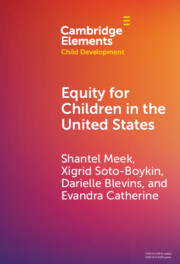358 results
6 - “Are You Poor?”
- from Part II - Online Activism
-
-
- Book:
- Translingual Practices
- Published online:
- 07 May 2024
- Print publication:
- 09 May 2024, pp 105-122
-
- Chapter
- Export citation

Equity for Children in the United States
-
- Published online:
- 27 April 2024
- Print publication:
- 23 May 2024
-
- Element
-
- You have access
- Open access
- HTML
- Export citation
20 - Action Civics
- from Part VI - Education and Engaged Research
-
-
- Book:
- The Cambridge Handbook of Community Empowerment
- Published online:
- 18 April 2024
- Print publication:
- 25 April 2024, pp 507-531
-
- Chapter
- Export citation
Chapter 5 - Dyslexia
-
- Book:
- The Dyslexia Debate Revisited
- Published online:
- 30 March 2024
- Print publication:
- 18 April 2024, pp 246-284
-
- Chapter
- Export citation
Chapter 6 - Conclusions and Recommendations
-
- Book:
- The Dyslexia Debate Revisited
- Published online:
- 30 March 2024
- Print publication:
- 18 April 2024, pp 285-299
-
- Chapter
- Export citation
From intention to action – cultivating future-ready One Health agents of change
-
- Journal:
- Research Directions: One Health / Volume 2 / 2024
- Published online by Cambridge University Press:
- 25 March 2024, e8
-
- Article
-
- You have access
- Open access
- HTML
- Export citation
Changing sustainable diet behaviours during the COVID-19 Pandemic: inequitable outcomes across a sociodemographically diverse sample of adults
-
- Journal:
- Journal of Nutritional Science / Volume 13 / 2024
- Published online by Cambridge University Press:
- 14 March 2024, e16
-
- Article
-
- You have access
- Open access
- HTML
- Export citation
Chapter 3 - Psychological Theories and Revolution
- from Part I - Getting to Revolutionary Collective Action
-
- Book:
- The Psychology of Revolution
- Published online:
- 07 March 2024
- Print publication:
- 14 March 2024, pp 35-56
-
- Chapter
- Export citation
21 - Educating All Children
- from Part II - Ethics and Education in Practice
-
-
- Book:
- The Cambridge Handbook of Ethics and Education
- Published online:
- 07 March 2024
- Print publication:
- 14 March 2024, pp 443-464
-
- Chapter
- Export citation
Programme d’été sur le vieillissement de l’Institut du vieillissement des Instituts de Recherche en Santé du Canada : trois pistes de réflexion de participants du Québec
-
- Journal:
- Canadian Journal on Aging / La Revue canadienne du vieillissement , First View
- Published online by Cambridge University Press:
- 13 March 2024, pp. 1-3
-
- Article
-
- You have access
- Open access
- HTML
- Export citation
5 - A Fascist Social Justice?
-
-
- Book:
- Social Justice in Twentieth-Century Europe
- Published online:
- 29 February 2024
- Print publication:
- 07 March 2024, pp 96-115
-
- Chapter
- Export citation
Equitable access to evidence-based treatment for eating disorders for patients with low-income: identifying barriers and exploring solutions
-
- Journal:
- The Cognitive Behaviour Therapist / Volume 17 / 2024
- Published online by Cambridge University Press:
- 19 February 2024, e5
-
- Article
-
- You have access
- HTML
- Export citation
3 - A Narrow View of Transnational Fiduciary Law
- from Part I - The Transnational Formation and Institutionalization of Fiduciary Law
-
-
- Book:
- Transnational Fiduciary Law
- Published online:
- 22 November 2023
- Print publication:
- 08 February 2024, pp 74-97
-
- Chapter
-
- You have access
- Open access
- HTML
- Export citation
How Do Past Immunization Strategies Compare With the COVID-19 Immunization Rollout: A New Zealand Analysis
-
- Journal:
- Disaster Medicine and Public Health Preparedness / Volume 18 / 2024
- Published online by Cambridge University Press:
- 08 February 2024, e18
-
- Article
-
- You have access
- Open access
- HTML
- Export citation
18 - Nonprofits as Creators of Transformative Symbolic Reality
- from Part III - New Directions
-
-
- Book:
- Reimagining Nonprofits
- Published online:
- 11 January 2024
- Print publication:
- 01 February 2024, pp 353-371
-
- Chapter
- Export citation

Innovative Funding and Financing for Infrastructure
- Addressing Scarcity of Public Resources
-
- Published online:
- 01 February 2024
- Print publication:
- 08 February 2024
Chapter 51 - Caring for People who Have Disabilities and Are Affected by Emergencies, Incidents, Disasters, and Disease Outbreaks
- from Section 6 - Designing, Leading, and Managing Responses to Emergencies and Pandemics
-
-
- Book:
- Major Incidents, Pandemics and Mental Health
- Published online:
- 11 January 2024
- Print publication:
- 01 February 2024, pp 388-393
-
- Chapter
- Export citation

Enough
- Because We Can Stop Cervical Cancer
-
- Published online:
- 11 January 2024
- Print publication:
- 11 January 2024
Chapter 7 - Teaching science inclusively
- from Part 2 - How can I enhance children’s learning of science?
-
-
- Book:
- Science in Early Childhood
- Published online:
- 13 December 2023
- Print publication:
- 10 January 2024, pp 104-118
-
- Chapter
- Export citation
12 - How preschool education in Sweden contributes to cultures for sustainability
- from Part 2
-
-
- Book:
- Young Children and the Environment
- Published online:
- 05 January 2024
- Print publication:
- 05 January 2024, pp 255-273
-
- Chapter
- Export citation



